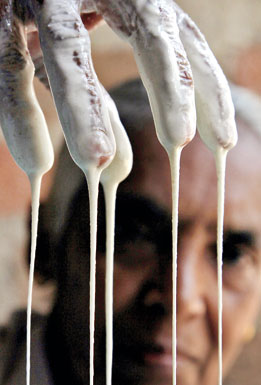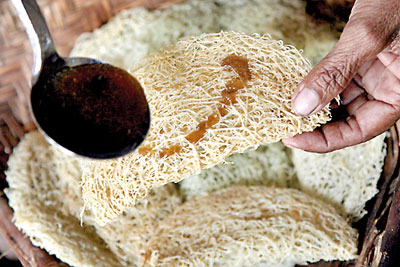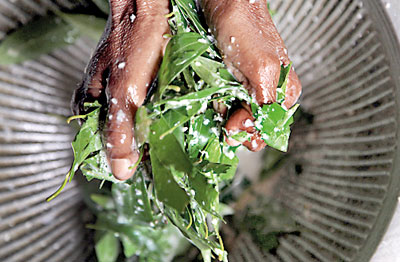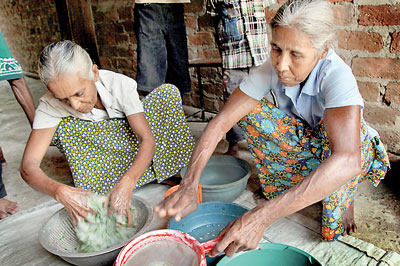Bring out those white beauties
View(s):A lesson in endurance and skill, this is what Kumudini Hettiarachchi learns from Jayasundera Mudiyanselage Susilawathi at a rural home in Thalahena as she turns out the mouth-watering traditional sweetmeat, aasmi
The table is laden with all the traditional sweetmeats and in homes across Sri Lanka all eyes would be on the clock for the auspicious time to partake of the first meal in the New Year. Among the kiribath, the konde kavum and the kokis, of equal importance, taking pride of place on the table would be the semi-circular snow-white aasmi with a line of treacle above it.

Just the right touch: Mixture flows down in the intricate process of making aasmi
Look again though at that melt-in-the mouth white beauty on the table. Is it the “pretender” we get in the cities or the authentic aasmi fresh from the frying pan of someone well-versed in the art of making traditional sweetmeats?
It was not only a lesson in making aasmi that the Sunday Times was privy to last Tuesday but also what trouble humble women in rural homes endure to bring aasmi to the table.
The work begins about a week or two ahead of the festivities. In the tiny 15-family village of Thalahena, close to Kobeigane in the Kurunegala district, the “bookings” have come fast and furious for Jayasu-ndera Mudiyanselage Susilawathi, 58. Susila Nenda to some and Susila Akka to others, has been booked to make aasmi for the different homes in Thalahena where all are kith and kin. It is not only for Avurudu that her skills as the aasmi-specialist are sought, but also at weddings, funerals and daanes (almsgivings).
Last Tuesday, it was to the home of P.M. Somawathi that she came in the morning. The preparations begin with the first task of pounding the kekulu rice — which has been soaked overnight in the mortar and pestle — after which the flour is sent through the sieve several times to get rid of the lumps and save the finely-pounded flour.
Then the search begins for the dawul kurundu or kuda-dawula (Neolitsea cassia or wild cinnamon) tree, for the one closest to Somawathi’s home has been stripped bare of its leaves (“nettatama kadala,” she smiles), for other homes have beaten Somawathi in the race against time in making aasmi.
Another tree with leaves is found elsewhere in the village and Somawathi takes a bundle home, making sure to select not the too tender or too mature leaves. While she is away, the helpers at home have scraped coconut in readiness for the leaves. Mixing the leaves with the finely-scraped coconut, the mixture is crushed well with both hands to bring out the gummy liquid (naanu). Clumps of leaves and coconut are then taken in the palm and squeezed tightly over a sieve to separate the naanu from the residue. This is while Somawathi has been busy making a fine dough of the rice-flour by adding thick coconut milk.
The time has now come for Susila Nenda’s skill to be shown off………..for when the naanu is added to the dough, the padama (consistency) has to be just right. The test comes when Susila dips her fingers in the mixture and raises it – fine lines, like unbroken threads, of the mixture stream down from her fingers.

Sweet finish: A trickle of treacle on top
Then begins a ritual to ensure the frying of many aasmi with as little oil as possible. For this, the empty frying pan is kept on the fire and the spoon and the koora kept atop the pan as a cross, pouring in the coconut oil without speaking a word. The silence, the village women believe will save them oil.
Dexterously Susila pours the liquidy dough into the makeshift pol-katu gotta with holes to which a handle has been fixed and moves it over the frying pan full of bubbling oil. Quickly and confidently as soon as a circular aasmi forms in the pan, Susila folds it to get a semi-circular shape, takes it off the pan and stacks it along with its cousins in a muttiya or box.
“Thel berrenna oney,” smiles Susila, explaining that they have to be kept for about a week for the oil to drain. While both she and Somawathi shoo away the little children who would like to grab an aasmi and nibble on it, she points out that after the “first-fry” the aasmi is “guru paatai” (brownish in colour).
The children are not allowed to steal an aasmi or two because the first and choicest portion of the Avurudu kevili is offered to the temple, once the hearth is bereft of fire and the family goes to the village temple during the Punya Kaalaya. It is just before the Punya Kaalaya when all housework and cooking stops that the brown aasmi is taken from the muttiya and given a quick dip in bubbling oil once again.
Out comes the aasmi from the “second-fry” white and crunchy-soft, on which is poured in different patterns pol or kithul peni (treacle) giving a dollop of colour at the top. The family will be able to take a bite of the aasmi on Avurudu (today) at 7.05 sharp in the morning, after a pot of milk is boiled in the newly-lit hearth to an explosion of fire-crackers and Somawathi and husband, A.A. Karunaratne, wearing copper-hued (a blend of red and yellow) clothes have lit the traditional oil lamp.

Green essence: Mixing in the dawul kurundu leaves.

Preparations begin for the making of aasmi, with Susila nenda (on the left) in the home of Somawathi (on the right). Pix by M.A. Pushpa Kumara
Follow @timesonlinelk
comments powered by Disqus















